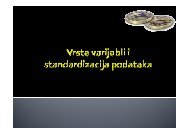View - ResearchGate
View - ResearchGate
View - ResearchGate
Create successful ePaper yourself
Turn your PDF publications into a flip-book with our unique Google optimized e-Paper software.
technics technologies education management<br />
First, this model assumes that within one of<br />
two forms of participation of managers in sport<br />
(usage, and business participation) lies the properties<br />
of managers-respondents themselves, including<br />
the properties of the company whose management<br />
they belong to, and they do not change for<br />
the long period of time so the subjects of managing<br />
sports organization can rely on them only as<br />
on the strategic factors with optimal or adverse<br />
effect. Second, we may assume that there are the<br />
characteristics of respondents that tend to change<br />
over a short period of time, and they reflect the<br />
changeable circumstances (situation) so the operational<br />
management of sports organization can rely<br />
on them (formulation of tactic ways for getting a<br />
manager to invest in sport).<br />
The starting relation refers to the development<br />
of participation of managers from usage to their<br />
business form. The users’ participation in this model<br />
is manifesting dependent variable in relation with<br />
exogenic manifesting variable (or battery of variables)<br />
of sports culture of managers. This last variable<br />
includes sport needs and habits of respondents<br />
gained while being into sport before their taking a<br />
position of manager in that company.<br />
The environment of the company is important<br />
for establishing and development of business participation<br />
of managers in sport. This environment<br />
is defined by three dimensions – a set of manifesting<br />
variables. The dimension of structure – which<br />
includes the characteristics of the company, its<br />
resources (employment, equipment), business<br />
potentials (funds, total income, accumulation),<br />
the position in the market (positioning, dynamic<br />
of business effects), its structure (the hierarchy<br />
of management), and especially socio-structural<br />
characteristics of managers (sex, age, marital status,<br />
education). This dimension includes the variables<br />
which do not change over a short period of<br />
time, so they act as determinants (the factors with<br />
timely predictable effects).<br />
The dimension of relationship – expresses the<br />
relationship between managing factors of the company<br />
and sport, current and future sport activities<br />
taken by the staff of the company, including managers<br />
(and members of their families), estimating<br />
business interest of the company for particular<br />
sport and concrete sports organization, attempts<br />
of the company to have interest through sport<br />
Volume 7 / Number 1 / 2012<br />
which cannot be achieved in any other way (with<br />
a lower business effect). This dimension includes<br />
variables that can vary in a shorter period of time<br />
and they represent dependent variables under the<br />
influence of structural dimensions of entrepreneur<br />
environment and sport culture of the managers.<br />
The dimension of the process – expresses manifesting<br />
effective relationship of the company and<br />
sport, use of sports services and resources of certain<br />
sports organizations (by employees and managers<br />
of the company), supporting sports organizations<br />
(free transport services, funds, financial donations),<br />
business transactions of the companies and certain<br />
sports organizations (compensations, business<br />
contracts, renting business premises, joint venture<br />
in additional activities of the sports organizations,<br />
advertising), sponsorship. This dimension sums up<br />
the effect of the two previous dimensions so it has<br />
an emphasized influence on the business participation<br />
of managers in sport (managers here act as<br />
authorized agents of the company). The list of all<br />
variables is given in Appendix 1.<br />
The determined relations of five dimensions of<br />
structural model do not include a more complex<br />
set of influence of exogenic and endogenic manifesting<br />
variables. The analysis does not include a<br />
probable set of latent variables which have not undergone<br />
empirical research procedure (they have<br />
not been considered in the formulated questions<br />
of the survey). In order to use this latent space in<br />
the structural model, we tested structural model by<br />
using SEPATH procedure (Statistica, Version 9.0).<br />
Results<br />
The main result obtained by empirical analysis<br />
(Figure 2) confirms that the following can be extracted<br />
from the collected empirical data: a) Three<br />
dimensions of independent variables (exogenic<br />
manifesting dimensions): 1) Structural characteristics<br />
of respondents (including their sport culture),<br />
2) The environment of the company, and 3)<br />
The environment of sports organization; b) Two<br />
dimensions of intermediary independent variables<br />
(manifesting endogenic dimensions): 1) The relationship<br />
of managers towards sport, and 2) The effects<br />
of participation; c) The dimension of criteria<br />
variables: Form and Duration of the participation<br />
of managers in sport.<br />
363






